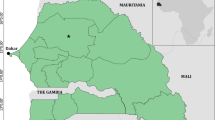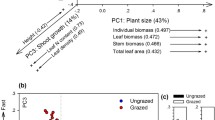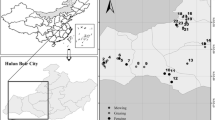Abstract
The trait-based approach aims to detect functional patterns in vegetation beyond specific sites or taxa. In most cases, plant traits are assumed to be linearly related to environmental gradients such as grazing intensity. To generalize results beyond specific sites, it is important to know to which extent environment-trait relationships are non-linear. Non-linearity can be a source of inconsistency among different studies according to length and studied portion of a gradient. In this study, we test if and to what extent traits relate non-linearly to a grazing gradient using data from a grassland-matorral interface in the Mediterranean rangeland of “La Crau” (SE France). Because quantification of grazing by itinerant sheep flocks is difficult, we use a marker plant, Phillyrea angustifolia, and several independent pasture indicators to estimate grazing intensity. First, we related traits to grazing using a multivariate three-table ordination method (RLQ), which assumes linear reactions of traits. To evaluate the importance of non-linearity, we applied generalized additive models (GAMs) to our data. This revealed that a third of traits studied here showed non-linear relationships to grazing. These non-linear responses cover a large spectrum including seed mass, life form, phenology dispersal- and leaf traits. The high part of non-linear relations compromises a general assumption of linear trait-environment relationships. Future works should therefore more often consider non-linear relationships using methods with no constraints on shape of response, e.g., GAM in the analysis of functional trait studies. In this way, non-linear relationships can reveal new aspects of species and community response to global change and deepen our understanding of trait-environment relations.


Similar content being viewed by others
Abbreviations
- GAM –:
-
Generalized Additive Models
- SLA:
-
Specific Leaf Area
References
Azcarate FM, Sanchez AM, Arqueros L, Peco B (2002) Abundance and habitat segregation in Mediterranean grassland species: the importance of seed weight. J Veg Sci 13:159–166
Badan O, Brun JP, Congès G (1995) Les bergeries Romaines de la Crau d’Arles. Gallia 52:263–310
Bekker RM, Kwak MM (2005) Life history traits as predictors of plant rarity, with a particular reference to hemiparasitic Orobanchaceae. Folia Geobot 40:231–242
Cingolani AM, Posse G, Collantes MB (2005) Plant functional traits, herbivore selectivity and response to sheep grazing in Patagonian steppe grasslands. J Appl Ecol 42:50–59
Cornelissen JHC, Lavorel S, Garnier E, Díaz S, Buchmann N, Gurvich DE, Reich PB, ter Steege H, Morgan HD, van der Heijden MGA, Pausas JG, Poorter H (2003) A handbook of protocols for standardised and easy measurement of plant functional traits worldwide. Austral J Bot 51:335–380
de Bello F, Lepš J, Sebastià MT (2005) Predictive value of plant traits to grazing along a climatic gradient in the Mediterranean. J Appl Ecol 42:824–833
De Bolòs O, Vigo J, Masalles RM, Ninot JM (1993) Flora Manual dels Països Catalans. Portic, Barcelona
Devaux JP, Archiloque A, Borel L, Bourrelly M, Louis-Alluel J (1983) Notice de la carte phytoécologique de la Crau (Bouches-du-Rhône). Biol & Écol Médit 10:5–54
Díaz S, Noy-Meir I, Cabido M (2001) Can grazing response of herbaceous plants be predicted from simple vegetative traits? J Appl Ecol 38:497–508
Díaz S, Lavorel S, McIntyre S, Falczuk V, Casanoves F, Milchunas DG, Skarpe C, Rusch G, Sternberg M, Noy-Meir I, Landsberg J, Zhang W, Clark H, Campbell BD (2007) Plant trait responses to grazing – a global synthesis. Global Change Biol 13:313–341
Dolédec S, Chessel D, ter Braak CJF, Champely S (1996) Matching species traits to environmental variables: a new three-table ordination method. Environm Ecol Statist 3:143–166
Dray S, Chessel D, Thioulouse J (2003) Co-inertia analysis and the linking of ecological data tables. Ecology 84:3078–3089
Dray S, Dufour AB, Chessel D (2007) The ade4-package: two-table and K-table methods. R News 7:47–52
Dupré C, Diekmann M (2001) Differences in species richness and life-history traits between grazed and abandoned grasslands in southern Sweden. Ecography 24:275–286
Evette A, Bédécarrats A, Bornette G (2009) Environmental constraints influence clonal traits of herbaceous plant communities in an alpine massif. Folia Geobot 44:95–108
Fabre P (1998) La Crau, depuis toujours terre d’élevage. In Cheylan G (ed) Patrimoine naturel et pratiques pastorales en Crau – pour une gestion globale de la plaine. C.E.E.P. Ecomusée de Crau, St Martin de Crau, pp 34–44
Fernández-Alés R, Laffarga JM, Ortega F (1993) Strategies in Mediterranean grassland annuals in relation to stress and disturbance. J Veg Sci 4:313–322
Flynn S, Turner RM, Dickie JB (2004) Seed Information Database (release 6.0, October 2004). Kew Botanical Gardens, Kew. Available at: http://www.rbgkew.org.uk/data/sid
Garnier E, Cordonnier P, Guillerm J-L, Sonié L (1997) Specific leaf area and leaf nitrogen concentration in annual and perennial grass species growing in Mediterranean old-fields. Oecologia 111:490–498
Garnier E, Laurent G, Bellman A, Debain S, Berthelier P, Ducout B, Roumet C, Navas ML (2001) Consistency of species ranking based on functional leaf traits. New Phytol 152:69–83
Garnier E, Cortez J, Billès G, Navas ML, Roumet C, Debussche M, Laurent G, Blanchard A (2004) Plant functional markers capture ecosystem properties during secondary succession. Ecology 85:2630–2637
Hadar L, Noy-Meir I, Perevolotsky A (1999) The effect of shrub clearing and grazing on the composition of a Mediterranean plant community: functional groups versus species. J Veg Sci 10:673–682
Hambäck PA, Beckerman AP (2003) Herbivory and plant resource competition a review of two interacting interactions. Oikos 101:26–37
Hastie TJ, Tibshirani RJ (1990) Generalized additive models. Chapman and Hall, London
Henry F, Talon B, Dutoit T (2010) The age and history of the French Mediterranean steppe revisited by soil wood charcoal analysis. The Holocene 20:25–34
Hurlbert SH (1984) Pseudoreplication and the design of ecological field experiments. Ecol Monogr 54:187–211
Kazakou E, Vile D, Shipley B, Gallet C, Garnier E (2006) Co-variations in litter decomposition, leaf traits and plant growth in species from a Mediterranean old-field succession. Funct Ecol 20:21–30
Kleyer M, Bekker RM, Knevel IC, Bakker JP, Thompson K, Sonnenschein M, Poschlod P, van Groenendael JM, Klimeš L, Klimešová J, Klotz S, Rusch GM, Hermy M, Adriaens D, Boedeltje G, Bossuyt B, Dannemann A, Endels P, Gotzenberger L, Hodgson JG, Jackel AK, Kuhn I, Kunzmann D, Ozinga WA, Romermann C, Stadler,M, Schlegelmilch J, Steendam HJ, Tackenberg O, Wilmann B, Cornelissen JHC, Eriksson O, Garnier E, Peco B (2008) The LEDA Traitbase: a database of life-history traits of the Northwest European flora. J Ecol 96:1266–1274
Landsberg J, Lavorel S, Stol J (1999) Grazing response groups among understory plants in arid rangelands. J Veg Sci 10:683–697
Landsberg J, James CD, Morton SR, Müller WJ, Stol J (2003) Abundance and composition of plant species along a grazing gradient in Australian rangelands. J Appl Ecol 40:1008–1024
Lavergne S, Garnier E, Debussche M (2003) Do rock endemic and widespread plant species differ under the Leaf–Height–Seed plant ecology strategy scheme? Ecol Lett 6:398–404
Lavorel S, McIntyre S, Landsberg J, Forbes TDA (1997) Plant functional classifications: from general groups to specific groups based on response to disturbance. Trends Ecol Evol 12:474–478
Lavorel, S, McIntyre, S, Grigullis, K (1999) Plant response to disturbance in a Mediterranean grassland: How many functional groups? J Veg Sci 10:661–672
Lavorel S, Díaz S, Cornelissen JHC, Garnier E, Harrison S, McIntyre S, Pausas JG, Pérez-Harguindeguy N, Roumet C, Urcelay C (2007) Plant functional types: are we getting any closer to the Holy Grail? In Canadell J, Pitelka LF, Pataki D (eds) Terrestrial ecosystems in a changing world. Springer Verlag, Heidelberg, pp 149–160
Leveau P (2004) L’herbe et la pierre dans les textes anciens sur la Crau: relire les sources écrites. Ecol Medit 30:25–33
Louault F, Pillar VD, Aufrère J, Garnier E, Soussana JF (2005) Plant traits and functional types in response to reduced disturbance in a semi-natural grassland. J Veg Sci 16:151–160
Massei G, Hartley SE, Bacon PJ (2000) Chemical and morphological variation of Mediterranean woody evergreen species: Do plants respond to ungulate browsing? J Veg Sci 11:1–8
McGill BJ, Enquist BJ, Weiher E, Westoby M (2006) Rebuilding community ecology from functional traits. Trends Ecol Evol 21:178–185
McIntyre S, Lavorel S (2001) Livestock grazing in sub-tropical pastures: steps in the analysis of attribute response and plant functional types. J Ecol 89:209–226
McIntyre S, Lavorel S, Trémont RM (1995) Plant life history attributes: their relationship to disturbance response in herbaceous vegetation. J Ecol 83:31–44
McIntyre S, Lavorel S, Landsberg J, Forbes TDA (1999) Disturbance response in vegetation: towards a global perspective on functional traits. J Veg Sci 10:621–630
Milchunas DG, Noy-Meir I (2002) Grazing refuges, external avoidance of herbivory and plant diversity. Oikos 99:113–130
Molinier R, Müller P (1938) La dissémination des espèces végétales. Rev Gén Bot 50:1–761
Molinier R, Tallon G (1950) La végétation de la Crau. Rev Gén Bot 56:1–111
Moog D, Kahmen S, Poschlod P (2005) Application of CSR- and LHS-strategies for the distinction of differently managed grasslands. Basic Appl Ecol 6:133–143
Olff H, Ritchie ME (1998) Effects of herbivores on grassland plant diversity. Trends Ecol Evol 13:261–265
Ortega M, Levassor C, Peco B (1997) Seasonal dynamics of Mediterranean pasture seed banks along environmental gradients. J Biogeogr 24:177–195
Ozinga WA, Römermann C, Bekker RM, Prinzig A, Tamis WLM, Schaminée JHJ, Hennekens SM, Thompson K, Poschlod P, Kleyer M, Bakker JP, van Groenendael JM (2008) Dispersal failure contributes to plant losses in NW Europe. Ecol Lett 11:1–9
Pakeman RJ (2004) Consistency of plant species and trait responses to grazing along a productivity gradient: a multi-site analysis. J Ecol 38:893–905
Peco B, Traba J, Levassor C, Sanchez AM, Azcarate FM (2003) Seed size and shape and persistence in dry Mediterranean grass and scrublands. Seed Sci Res 13:87–95
Peco B, de Pablos I, Traba J, Levassor C (2005) The effect of grazing and abandonment on species composition and functional traits: The case of Dehesa grasslands. Basic Appl Ecol 6:175–183
Poorter H, De Jong R (1999) A comparison of specific leaf area, chemical composition and leaf construction costs of field plants from 15 habitats differing in productivity. New Phytol 143:163–176
Poschlod P, Kleyer M, Jackel AK, Dannemann A, Tackenberg O (2003) Biopop – a database of plant traits and internet application for nature conservation. Folia Geobot 38:263–271
R Development Core Team (2009) R: A language and environment for statistical computing. R foundation for Statistical Computing, Vienna. Available at: http://www.R-project.org
Römermann C, Tackenberg O, Poschlod P (2005) How to predict attachment potential of seeds to sheep and cattle coat from simple morphological seed traits. Oikos 110:219–230
Römermann C, Tackenberg O, Jackel AK, Poschlod P (2008) Eutrophication and fragmentation are related to species’ rate of decline but not to species rarity: results from a functional approach. Biodivers & Conservation 17:591–604
Smart SM, Bunce RGH, Marrs R, Le Duc M, Firbank LG, Maskell LC, Scott WA, Thompson K, Walker KJ (2005) Large-scale changes in the abundance of common higher plant species across Britain between 1978, 1990 and 1998 as a consequence of human activity: Test of hypothesized changes in trait representation. Biol Conservation 124:355–371
Thompson K (1994) Predicting the fate of temperate species in response to human disturbance and global change. In Boyle TJB, Boyle CEB (eds) Biodiversity, temperate ecosystems, and global change. Springer Verlag, Heidelberg, pp 61–76
Thompson K, Bakker JP, Bekker RM (1997) The soil seed banks of North West Europe. Cambridge University Press, Cambridge
VDLUFA (1991) Methodenbuch 1. Die Untersuchung von Böden. VDLUFA, Darmstadt
Véla E, Hill B, Della-Casa S (1999) Liste des plantes vasculaires du département des Bouches-du-Rhône (France). Bull Soc Linn Provence 50:115–201
Vesk PA, Leishman MR, Westoby M (2004) Simple traits do not predict grazing response in Australian dry shrublands and woodlands. J Appl Ecol 41:22–31
Violle C, Navas ML, Vile D, Kazakou E, Fortunel C, Hummel I, Garnier E (2007) Let the concept of trait be functional! Oikos 116:882–892
Weiher E, van der Werf A, Thompson K, Roderick M, Garnier E, Eriksson O (1999) Challenging Theophrastus: A common core list of plant traits for functional ecology. J Veg Sci 10:609–620
Westoby M (1998) A leaf-height-seed (LHS) plant ecology strategy scheme. Pl & Soil 199:213–227
Wood SN (2006) Generalized additive models: an introduction with R. Chapman & Hall, London
Acknowledgements
We are grateful to Elise Buisson and Mathilde Catoire for help with field work; Errol Vela and Daniel Pavon helped in identification problems, Ulrich Deil and Franck Bode (Freiburg) for technical support and the Centre d’Etudes d’Ecosystèmes Provençaux (C.E.E.P) for accommodation, working material and access to the study site. We thank two anonymous reviewers and the associated editor, Michal Hájek, for helpful comments on earlier versions of this paper.
Author information
Authors and Affiliations
Corresponding author
Electronic supplementary material
Below is the link to the electronic supplementary material.
ESM 1
(DOC 631 kb)
Rights and permissions
About this article
Cite this article
Saatkamp, A., Römermann, C. & Dutoit, T. Plant Functional Traits Show Non-Linear Response to Grazing. Folia Geobot 45, 239–252 (2010). https://doi.org/10.1007/s12224-010-9069-2
Received:
Accepted:
Published:
Issue Date:
DOI: https://doi.org/10.1007/s12224-010-9069-2




